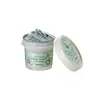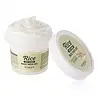What's inside
What's inside
 Key Ingredients
Key Ingredients

 Benefits
Benefits

 Concerns
Concerns

 Ingredients Side-by-side
Ingredients Side-by-side

Water
Skin ConditioningPyrus Communis Fruit Extract
Skin ConditioningKaolin
AbrasiveTapioca Starch
Glycerin
HumectantBentonite
AbsorbentPalmitic Acid
EmollientStearic Acid
CleansingMyristic Acid
CleansingLauric Acid
CleansingPotassium Hydroxide
BufferingGlyceryl Stearate
EmollientMentha Suaveolens Leaf Extract
AstringentMentha Piperita Leaf Extract
Skin ConditioningMentha Viridis Leaf Extract
MaskingOryza Sativa Powder
Butylene Glycol
HumectantPeucedanum Graveolens Extract
TonicLactobacillus/Hibiscus Sabdariffa Flower Ferment Filtrate
Skin ConditioningTriticum Vulgare Sprout Extract
Skin ConditioningBrassica Oleracea Italica Extract
AstringentBrassica Oleracea Capitata Leaf Extract
Skin ConditioningApium Graveolens Extract
Skin ConditioningBrassica Oleracea Acephala Leaf Extract
HumectantPortulaca Oleracea Extract
Skin ConditioningC12-14 Pareth-12
EmulsifyingJuglans Regia Shell Powder
AbrasiveHydroxypropyl Methylcellulose
Emulsion StabilisingCaprylyl Glycol
Emollient1,2-Hexanediol
Skin ConditioningCI 42090
Cosmetic ColorantParfum
MaskingWater, Pyrus Communis Fruit Extract, Kaolin, Tapioca Starch, Glycerin, Bentonite, Palmitic Acid, Stearic Acid, Myristic Acid, Lauric Acid, Potassium Hydroxide, Glyceryl Stearate, Mentha Suaveolens Leaf Extract, Mentha Piperita Leaf Extract, Mentha Viridis Leaf Extract, Oryza Sativa Powder, Butylene Glycol, Peucedanum Graveolens Extract, Lactobacillus/Hibiscus Sabdariffa Flower Ferment Filtrate, Triticum Vulgare Sprout Extract, Brassica Oleracea Italica Extract, Brassica Oleracea Capitata Leaf Extract, Apium Graveolens Extract, Brassica Oleracea Acephala Leaf Extract, Portulaca Oleracea Extract, C12-14 Pareth-12, Juglans Regia Shell Powder, Hydroxypropyl Methylcellulose, Caprylyl Glycol, 1,2-Hexanediol, CI 42090, Parfum
Water
Skin ConditioningCaprylic/Capric Triglyceride
MaskingCyclopentasiloxane
EmollientCetyl Alcohol
EmollientPropylene Glycol
HumectantOryza Sativa Bran Water
MaskingGlycerin
HumectantPolysorbate 80
EmulsifyingJojoba Esters
EmollientPEG-100 Stearate
Glyceryl Stearate
EmollientPalmitic Acid
EmollientStearic Acid
CleansingSorbitan Stearate
EmulsifyingDimethicone
EmollientCarbomer
Emulsion StabilisingPotassium Hydroxide
BufferingAlgin
MaskingSucrose Cocoate
EmulsifyingTocopheryl Acetate
AntioxidantSodium Hyaluronate
HumectantPolyglutamic Acid
Skin ConditioningCeramide AP
Skin Conditioning1,2-Hexanediol
Skin ConditioningEthylhexylglycerin
Skin ConditioningPhenoxyethanol
PreservativeParfum
MaskingWater, Caprylic/Capric Triglyceride, Cyclopentasiloxane, Cetyl Alcohol, Propylene Glycol, Oryza Sativa Bran Water, Glycerin, Polysorbate 80, Jojoba Esters, PEG-100 Stearate, Glyceryl Stearate, Palmitic Acid, Stearic Acid, Sorbitan Stearate, Dimethicone, Carbomer, Potassium Hydroxide, Algin, Sucrose Cocoate, Tocopheryl Acetate, Sodium Hyaluronate, Polyglutamic Acid, Ceramide AP, 1,2-Hexanediol, Ethylhexylglycerin, Phenoxyethanol, Parfum
 Reviews
Reviews

Ingredients Explained
These ingredients are found in both products.
Ingredients higher up in an ingredient list are typically present in a larger amount.
1,2-Hexanediol is a synthetic liquid and another multi-functional powerhouse.
It is a:
- Humectant, drawing moisture into the skin
- Emollient, helping to soften skin
- Solvent, dispersing and stabilizing formulas
- Preservative booster, enhancing the antimicrobial activity of other preservatives
Glycerin is already naturally found in your skin. It helps moisturize and protect your skin.
A study from 2016 found glycerin to be more effective as a humectant than AHAs and hyaluronic acid.
As a humectant, it helps the skin stay hydrated by pulling moisture to your skin. The low molecular weight of glycerin allows it to pull moisture into the deeper layers of your skin.
Hydrated skin improves your skin barrier; Your skin barrier helps protect against irritants and bacteria.
Glycerin has also been found to have antimicrobial and antiviral properties. Due to these properties, glycerin is often used in wound and burn treatments.
In cosmetics, glycerin is usually derived from plants such as soybean or palm. However, it can also be sourced from animals, such as tallow or animal fat.
This ingredient is organic, colorless, odorless, and non-toxic.
Glycerin is the name for this ingredient in American English. British English uses Glycerol/Glycerine.
Learn more about GlycerinGlyceryl Stearate is a mix of glycerin and stearic acid.
It is used to stabilize the mixing of water and oil ingredients. By preventing these ingredients from separating, it can help elongate shelf life. It can also help thicken the product's texture.
As an emollient, it helps soften skin and supports barrier-replenishing ingredients.
In cosmetics, Glyceryl Stearate is often made from vegetable oils or synthetically produced.
This ingredient may not be fungal-acne safe
Fun fact: The human body also creates Glyceryl Stearate naturally.
Learn more about Glyceryl StearatePalmitic Acid is a fatty acid naturally found in our skin and in many plant and animal sources. In cosmetics, it is usually derived from palm oil. It serves many purposes in skincare, acting as a cleanser, emollient, and emulsifier.
As an emollient, palmitic acid helps soften and smooth the skin by preventing water loss. In cleansers, it helps remove oil and dirt while creating foam.
Its emulsifying properties help stabilize products by keeping water and oil-based ingredients from separating.
This may not be suitable for fungal acne-prone skin, as fatty acids like this can sometimes trigger breakouts in sensitive individuals.
Learn more about Palmitic AcidParfum is a catch-all term for an ingredient or more that is used to give a scent to products.
Also called "fragrance", this ingredient can be a blend of hundreds of chemicals or plant oils. This means every product with "fragrance" or "parfum" in the ingredients list is a different mixture.
For instance, Habanolide is a proprietary trade name for a specific aroma chemical. When used as a fragrance ingredient in cosmetics, most aroma chemicals fall under the broad labeling category of “FRAGRANCE” or “PARFUM” according to EU and US regulations.
The term 'parfum' or 'fragrance' is not regulated in many countries. In many cases, it is up to the brand to define this term.
For instance, many brands choose to label themselves as "fragrance-free" because they are not using synthetic fragrances. However, their products may still contain ingredients such as essential oils that are considered a fragrance by INCI standards.
One example is Calendula flower extract. Calendula is an essential oil that still imparts a scent or 'fragrance'.
Depending on the blend, the ingredients in the mixture can cause allergies and sensitivities on the skin. Some ingredients that are known EU allergens include linalool and citronellol.
Parfum can also be used to mask or cover an unpleasant scent.
The bottom line is: not all fragrances/parfum/ingredients are created equally. If you are worried about fragrances, we recommend taking a closer look at an ingredient. And of course, we always recommend speaking with a professional.
Learn more about ParfumPotassium hydroxide is commonly known as caustic potash. It is used to fix the pH of a product or as a cleaning agent in soap. In cleansers, it is used for the saponification of oils.
Sapnification is the process of creating fatty acid metal salts from triglycerides and a strong base. During this process, Potassium Hydroxide is used up and is not present in the final product.
Using high concentrations of Potassium Hydroxide have shown to irritate the skin.
Learn more about Potassium HydroxideStearic Acid is a fatty acid. It is an emollient, emulsifier, and texture enhancer.
As an emollient, stearic acid helps soften skin. It aids the skin's protective barrier by preventing water loss. It also provides a gentle cleansing effect without stripping away natural oils.
Stearic acid may also be used to enhance the texture of products. It can add volume and stabilize ingredients such as water and oil. This can help water and oil ingredients from separating.
Sources of stearic acid include animal or vegetable fats/oils such as coconut or shea. It can be naturally found in butter, cocoa butter, shea butter, vegetable fats, and animal tallow.
This ingredient may not be Malassezia folliculitis, or fungal-acne safe.
Learn more about Stearic AcidWater. It's the most common cosmetic ingredient of all. You'll usually see it at the top of ingredient lists, meaning that it makes up the largest part of the product.
So why is it so popular? Water most often acts as a solvent - this means that it helps dissolve other ingredients into the formulation.
You'll also recognize water as that liquid we all need to stay alive. If you see this, drink a glass of water. Stay hydrated!
Learn more about Water